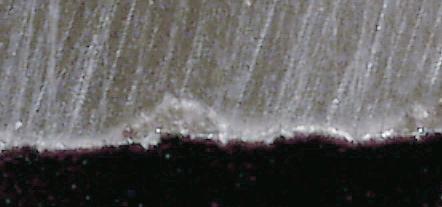A cutting edge can lose its sharpness in three ways. It can bend or deform, it can chip, or it can abrade or wear away. The first two cause premature loss of sharpness, making a freshly sharpened edge perform badly after only a few cuts. I consider deformation and chipping to be edge failure, in contrast to loss of sharpness due to abrasion. Abrasion happens more slowly and allows the blade to perform well for a considerable amount of work. Since no material exists that will hold an edge that never dulls, loss of sharpness due to abrasion is as good as it gets.
Deformation is a problem when the steel in the blade edge is soft and the bevel angle is too acute. Increasing the bevel angle may solve the problem.
The image below shows the edge of a Sorby chisel that was used for mortising. The edge was too acute and the steel was too soft to stand up to this use, so parts of the edge were pushed back to form the long dents in the edge. (My thanks to Bill Tindall for supplying this image.)

Here’s another image showing deformation, this one of an edge that was used to plane dried yellow glue.

Deformation failure can be recognized by the rounded shape and smooth surfaces of the defect.
Chipping occurs when the steel is brittle, which often accompanies increased hardness. A bevel that is too acute will cause a brittle steel to chip in use. Again, increasing the bevel angle will solve the problem.
The image below shows a plane blade with small chips that resulted when a 25º bevel was used to plane pine end grain. The edge was too delicate for this use, and chips about .002” deep occurred at the cutting edge. The same blade cut without chipping when the bevel was increased to 30º.

Abrasion takes place at different rates depending on many factors, including the type of steel and its heat treatment, the material it is being used to cut, and the geometry of the tool. For this study I am ignoring the different causes of wear such as chemical erosion, and use the term abrasion broadly to include whatever type of wear occurs when a steel blade is used to cut wood.
Here’s an image of a blade with considerable wear due to abrasion:

This blade had been used to plane a veneered surface down through a layer of yellow glue to the medium-density fiberboard substrate. Although this edge shows much more wear than any of my edge retention tests produce, it still was taking a shaving. Note the rounded shape of the edge. This image shows the bevel side of the blade, which faces the wood being planed. The flat side of the blade that faces up during use shows less rounding, but a larger area of it becomes polished by the shaving as it escapes the plane.